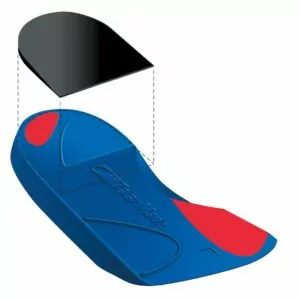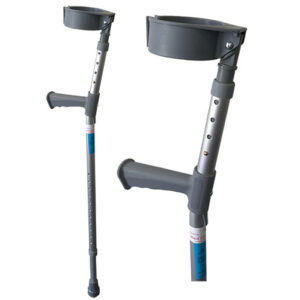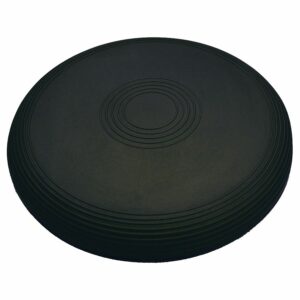Tibialis Posterior Tendonitis
Updated:
(Also known as Tibialis Posterior Tendinopathy, Posterior Tibial Tendinitis, Tibialis Posterior Tendinosis)
N.B. Although recent research suggests that ‘tibialis posterior tendinopathy’ is the more appropriate term to describe overuse injuries to the tibialis posterior tendon, we will use the term ‘tibialis posterior tendonitis’ in this document as it is more widely known.
What is tibialis posterior tendonitis?
Tibialis posterior tendonitis is a condition characterized by tissue damage and sometimes swelling of the tibialis posterior tendon, usually following overuse, resulting in pain located at the inner aspect of the lower leg and ankle.
The tibialis posterior muscle originates from the back of the tibia and fibula (lower leg bones), it then travels down along the inside of the lower leg and ankle (behind the inner ankle bone) where it inserts into various bones in the foot via the tibialis posterior tendon (figure 1). The tibialis posterior muscle is responsible for moving the foot and ankle towards the midline of the body (inversion – figure 2) and pointing the foot and ankle down (plantarflexion – figure 3). It also helps to maintain the normal arch of your foot and is particularly active during weight-bearing activity such as walking and running.
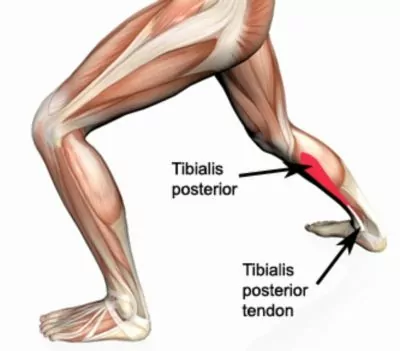
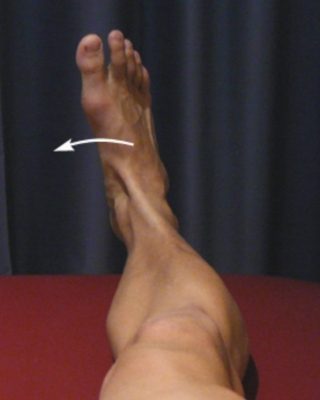
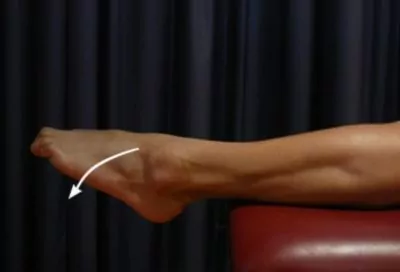
Whenever the tibialis posterior muscle contracts or is stretched, tension is placed through the tibialis posterior tendon. If this tension is excessive due to too much force or repetition, damage to the tibialis posterior tendon may occur. Tibialis posterior tendonitis is a condition where there is damage to the tendon with subsequent degeneration and sometimes swelling. This may occur traumatically due to a high force going through the tendon beyond what it can withstand or more commonly due to gradual wear and tear associated with overuse.
Causes of tibialis posterior tendonitis
Tibialis posterior tendonitis is usually an overuse injury, which commonly occurs due to repetitive or prolonged activities placing strain on the tibialis posterior tendon. This typically occurs due to excessive walking or running (especially up slopes or on uneven surfaces), jumping, hopping or change of direction activities. It is more common in patients with poor foot biomechanics (i.e. flat feet), inappropriate footwear and in those who have had a recent increase in training or activity.
Occasionally, patients may develop this condition suddenly due to a forceful contraction of the tibialis posterior muscle often when in a position of stretch. This typically occurs during rapid acceleration whilst running (particularly when changing direction).
Tibialis posterior tendonitis is commonly seen in running sports such as football, hockey and athletics (particularly distance runners) as well as in speed skating.
Signs and symptoms of tibialis posterior tendonitis
Patients with this condition typically experience pain in the region of the inner lower leg and ankle. In less severe cases, patients may only experience an ache or stiffness that increases with rest following activities requiring strong or repetitive contraction of the tibialis posterior muscle. These activities typically include excessive walking or running (especially uphill, on uneven surfaces or in poor footwear), jumping, hopping or change of direction activities. The pain associated with this condition may also warm up with activity in the initial stages of the condition.
As the condition progresses, patients may also experience pain during these activities affecting performance. The pain associated with this condition tends to be of gradual onset which progressively worsens over weeks to months with continuation of aggravating activities. In severe cases, the patient may be unable to continue the activity and may walk with a limp as a result of the pain. Patients with this condition may also experience pain on firmly touching the tibialis posterior tendon (figure 1) and sometimes on performing one or more single leg heel raises.
Diagnosis of tibialis posterior tendonitis
A thorough subjective and objective examination from a physiotherapist may be sufficient to diagnose a tibialis posterior tendonitis. Further investigations such as an X-ray, ultrasound, MRI or CT scan may be required occasionally, to confirm diagnosis, rule out other conditions and assess the severity of the condition.
Treatment for tibialis posterior tendonitis

Members Only ContentBecome a PhysioAdvisor Member to gain full access to this exclusive content. For more details see Become a Member. Already a member? Login Now
Contributing factors to the development of tibialis posterior tendonitis
There are several factors which can predispose patients to developing this condition. These need to be assessed and corrected with direction from a physiotherapist and may include:
- poor foot biomechanics (especially flat feet)
- inappropriate or excessive training or activity
- inadequate recovery periods from sport or activity
- inappropriate footwear
- muscle weakness (particularly of the tibialis posterior, calf, quadriceps and gluteals)
- muscle tightness (particularly of the tibialis posterior and calf)
- joint stiffness (particularly the ankle, foot, knee, hip and lower back)
- inadequate warm up
- inadequate rehabilitation following a previous lower limb injury
- change in training conditions or surfaces
- inappropriate running technique
- inadequate fitness
- inadequate warm up
- poor pelvic and core stability
- being overweight
Physiotherapy for tibialis posterior tendonitis
Physiotherapy treatment is vital to hasten the healing process, ensure an optimal outcome and reduce the likelihood of injury recurrence in all patients with tibialis posterior tendonitis. Treatment may comprise:
- soft tissue massage
- dry needling
- electrotherapy (e.g. ultrasound)
- joint mobilization
- stretches
- arch support taping
- bracing
- the use of crutches
- the use of heel wedges
- ice or heat treatment
- the use of a compression bandage
- exercises to improve strength, flexibility, balance and core stability
- education
- anti-inflammatory advice
- activity modification advice
- biomechanical correction (e.g. the use of orthotics)
- footwear advice
- a gradual return to activity program
Prognosis of tibialis posterior tendonitis
Most patients with this condition heal well with an appropriate physiotherapy program. This, however, can be a lengthy process and may take several months in patients who have had their condition for a long period of time. Minor cases of this condition that are identified and treated early can usually settle within a few weeks. Early physiotherapy treatment is vital to hasten recovery and ensure an optimal outcome.
Other Intervention for tibialis posterior tendonitis
Despite appropriate physiotherapy management, a small percentage of patients with this condition do not improve adequately. When this occurs the treating physiotherapist or doctor can advise on the best course of management. This may involve further investigation such as an X-ray, Ultrasound, CT scan or MRI, corticosteroid injection, autologous blood injection, pharmaceutical intervention or a review by a specialist who can advise on any procedures that may be appropriate to improve the condition. A review with a podiatrist for the prescription of orthotics and appropriate footwear advice may also be indicated.
Exercises for tibialis posterior tendonitis
The following exercises are commonly prescribed to patients with this tibialis posterior tendonitis. You should discuss the suitability of these exercises with your physiotherapist prior to beginning them. Generally, they should be performed 3 times daily and only provided they do not cause or increase symptoms.
Your physiotherapist can advise when it is appropriate to begin the initial exercises and eventually progress to the intermediate, advanced and other exercises. As a general rule, addition of exercises or progression to more advanced exercises should take place gradually and provided there is no increase in symptoms.
Initial Exercises
Foot and Ankle Up and Down
Move your foot and ankle up and down as far as you can go without pain and provided you feel no more than a mild to moderate stretch (figure 4). Repeat 10 – 20 times provided the exercise is pain free.
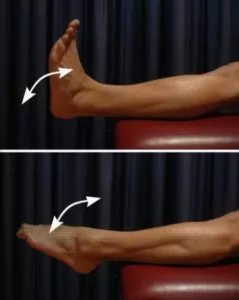
Foot and Ankle In and Out
Move your foot and ankle in and out as far as you can go without pain and provided you feel no more than a mild to moderate stretch (figure 5). Repeat 10 – 20 times provided the exercise is pain free.
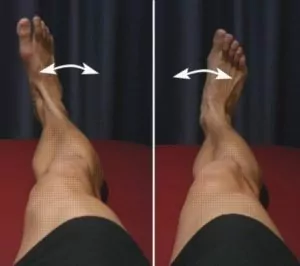
Lunge Stretch
With your hands against the wall, place your leg to be stretched in front of you as demonstrated (figure 6). Keep your heel down. Gently move your knee forward over your toes as far as you can go without pain and provided you feel no more than a mild to moderate stretch. Hold for 5 seconds and repeat 10 times at a mild to moderate stretch provided the exercise is pain free.
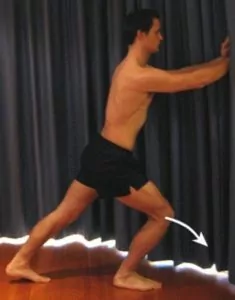

Members Only ContentBecome a PhysioAdvisor Member to gain full access to this exclusive content. For more details see Become a Member. Already a member? Login Now
Intermediate Exercises

Members Only ContentBecome a PhysioAdvisor Member to gain full access to this exclusive content. For more details see Become a Member. Already a member? Login Now
Advanced Exercises

Members Only ContentBecome a PhysioAdvisor Member to gain full access to this exclusive content. For more details see Become a Member. Already a member? Login Now
Other Exercises

Members Only ContentBecome a PhysioAdvisor Member to gain full access to this exclusive content. For more details see Become a Member. Already a member? Login Now
Rehabilitation Protocol for tibialis posterior tendonitis

Members Only ContentBecome a PhysioAdvisor Member to gain full access to this exclusive content. For more details see Become a Member. Already a member? Login Now
 Find a Physio for tibialis posterior tendonitis
Find a Physio for tibialis posterior tendonitis
Find a physiotherapist in your local area who can treat tibialis posterior tendonitis.
 Physiotherapy products for tibialis posterior tendonitis
Physiotherapy products for tibialis posterior tendonitis
Some of the most commonly recommended products by physiotherapist for patients with this tibialis posterior tendonitis include:
To purchase physiotherapy products for tibialis posterior tendonitis click on one of the above links or visit the PhysioAdvisor Shop.
 Other exercises
Other exercises
- Ankle Stretches.
- Ankle Strengthening Exercises.
- Leg Stretches.
- Leg Strengthening Exercises.
- Balance Exercises.
 More information
More information
- How to Use Crutches
- Ice or Heat
- R.I.C.E. Regime.
- Do I Need Orthotics?
- Return to Running Program.
- Returning to Sport.
- Why is my injury not improving?
- Ankle Diagnosis Guide.
Become a PhysioAdvisor Member
-
 Individual Membership (12 Months)$59.95 for 1 year
Individual Membership (12 Months)$59.95 for 1 year -
 Individual Membership (3 Months)$39.95 for 3 months
Individual Membership (3 Months)$39.95 for 3 months -
 Individual Membership (Yearly)$49.95 / year
Individual Membership (Yearly)$49.95 / year -
 Individual Membership (Monthly)$15.95 / month
Individual Membership (Monthly)$15.95 / month

Link to this Page
If you would like to link to this article on your website, simply copy the code below and add it to your page:
<a href="https://physioadvisor.com.au/injuries/ankle/tibialis-posterior-tendonitis”>Tibialis Posterior Tendonitis – PhysioAdvisor.com</a><br/>PhysioAdvisor offers detailed physiotherapy information on tibialis posterior tendonitis including causes, signs and symptoms, diagnosis, treatment, exercises, rehabilitation protocol and more...
Return to the top of Tibialis Posterior Tendonitis.


